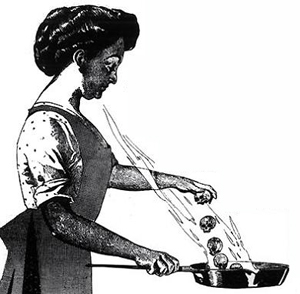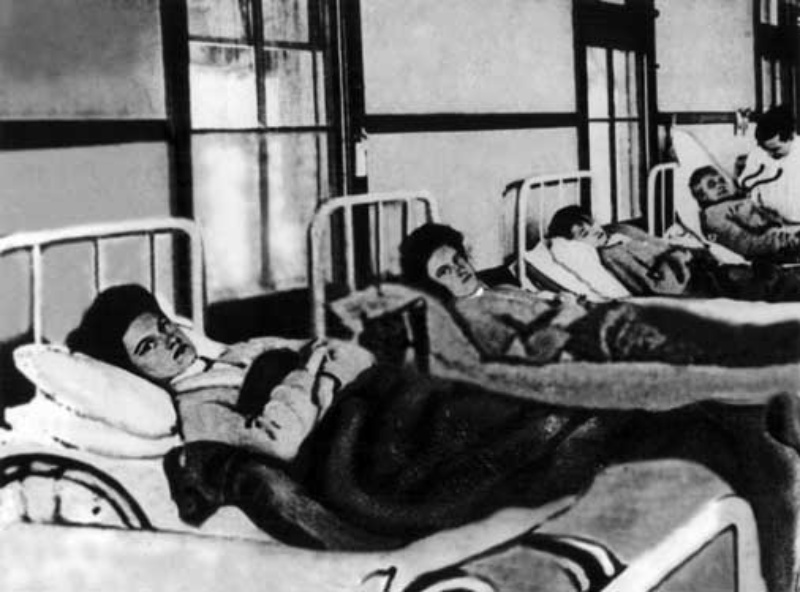by Carla Dominguez
Earlier this month, it was confirmed that there are more than 100 cases of measles in the United States—the largest outbreak in the post-vaccination era. An urban legend quickly circulated about a single unvaccinated woman who had traveled to Disneyland, spreading the disease.
This misinformation fueled the dispute between those who choose to vaccinate themselves and their children and those who believe, despite reassurances to the contrary from scientists and doctors, that the harm of vaccination outweighs the good. We are far from an epidemic, but that doesn’t stop the conversations about possible quarantine. What happens when disease and treatment get too political?
Mary Mallon was at the heart of precisely this controversy in the early 1900s. An outbreak of typhoid fever, a disease long associated with poverty and slums, emerged in the homes of wealthy New Yorkers in Long Island, infecting thirty-one and killing three. The blame was put solely upon Mallon—even though she had no symptoms of the disease.
The summer of 1906 was alarming to the residents of affluent Oyster Bay, Long Island. During their summer stay, the young daughter of the Warren family became ill and was diagnosed with typhoid fever. In the same week, two more members of the family and three of their house servants suffered the same fate. The young daughter eventually died. George Thompson, the owner of the house the Warrens had rented for the summer, was particularly concerned: The rich weren’t supposed to get typhoid, especially not the rich in Oyster Bay. At the time, typhoid was associated with poverty, slums, and immigrants. Thompson hired George Soper, a civil engineer, to find out how typhoid could have made its way into his luxurious home.
Soper soon focused on Mary Mallon. He discovered that Mallon, who had worked as a cook, had left three weeks after the young daughter had started showing symptoms. In fact, Soper found a trail of families affected with typhoid that had hired Mallon as a cook. Like a detective tracking down a criminal, Soper located Mallon at the home of her new employer on Park Avenue and asked her to come with him immediately for the sake of society, to submit to testing, telling her that she was a carrier of typhoid and at fault for spreading the disease to dozens of people. She refused, and chased Soper away with a carving fork.
Mallon is best known for being the first asymptomatic carrier of typhoid bacilli to be identified in the United States, although she showed no symptoms whatsoever, she was carrying typhoid fever and passing it through the food she prepared to members of various households in the area—and killing them.
Mallon resisted the calls of various health officials to restrict her work and her life, however; she argued there was no reason to take her away or test her. Her lack of cooperation and her extreme contagiousness led to her unfortunate nickname: Typhoid Mary.
It took months before a health official and five policemen managed to apprehend Mallon for testing. Soper was unable to get her to cooperate, even after approaching her at her work for a second time. He handed over his hypothesis to Hermann Biggs at the New York City Health Department, who sent Dr. S. Josephine Baker and five policemen to talk to Mallon. After a five-hour search Mallon was apprehended. Typhoid bacilli were found in her feces and she was sent to North Brother Island, a quarantine island in New York by the health officials and held without a trial.
The case of Mary Mallon brings attention to the fine line between protecting the public and preserving the civil rights of people who are a potential health risk. Mallon refused to believe she had the ability to infect others when she herself never showed any symptoms; she never accepted that she was responsible for spreading typhoid. Mallon sued for her freedom in her first few years on North Brother Island, and was let go under the pretense of her never working as a cook again. After her release however, she continued to work as a cook under a different name. In January of 1915, five years after Mallon was released, the Sloane Maternity Hospital in Manhattan suffered a typhoid-fever outbreak. Twenty-five people became ill and two died. Soon, it was discovered that a recently hired cook, “Mrs. Brown,” was in fact Mary Mallon. Caught again, this time Mallon allowed herself to be taken away without struggle, and was kept at North Brother Island for the remaining twenty-three years of her life.
It’s easy to think of Mallon as ignorant and uncaring of the lives of others, but that stance quickly becomes complicated. The issue was that although Mary Mallon made detrimental decisions, the health system made awful decisions as well. Mallon genuinely was confused about how she could possibly be a carrier of typhoid and the facts of this were never explained to her satisfaction. She argued that her own good health was proof that the doctors were incorrect. Knowing that typhoid was associated with poverty and filth, she felt that she had been targeted because she was poor and an Irish immigrant.
Mary Mallon might have broken her original promise and gone back to cooking because it was her profession, her way to make a living. There was no welfare system that could give her support after her initial release from quarantine: She left North Brother Island an unemployed, middle-aged Irish immigrant and single woman.
Mallon was never given a full explanation of her condition. Instead, she was humiliated in the media as a villain. “If they had shown some personal respect for how difficult it was for Mary Mallon to cope with what happened to her, it is conceivable that she would have responded in kind and come to respect their position. As it happened, neither side considered the other, and communication was stopped short,” writes Judith Walzer Leavitt, a professor of medical history at the University of Wisconsin, Madison, in a 2004 blog post for PBS.
As we consider the recent measles outbreak, Mary Mallon’s case underscores the dilemma that is public health. Should we insist on isolating and locking up people who are sick or at a risk of threatening the health of people around them? People who carry disease are viewed as if they intentionally bring sickness and death to others, or are ignorant and selfish people who care about only themselves.
Leavitt weighs in:
“Wherever we position ourselves, as individuals and as a society, we must come to terms with the fundamental issue that whether we think of them as guilty or innocent, people who seem healthy can indeed carry disease and under some conditions may menace the health of those around them. We can blame, fear, reject, sympathize, and understand: withal, we must decide what to do. Optimally, we search for responses that are humane to the sufferers and at the same time protect those who are still healthy.”
This conflict will never disappear. Civil liberties and public health will always go head to head, but perhaps it is possible to work towards a system where individuals that are carrying a disease are still respected and heard.
Mary Mallon was not the only person on North Brother Island who felt confused, isolated, and rejected from society without a full explanation. Perhaps she would have cooperated with health officials if her economic security was maintained and if she had been treated fairly.
For more information, watch The Most Dangerous Woman In America
Read Leavitt’s blog post here.












